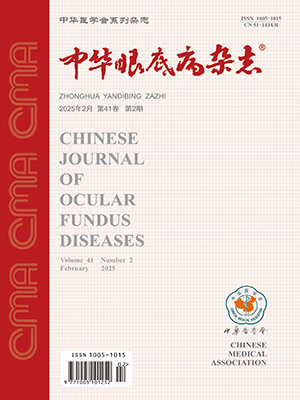Objective To investigate the application of critical flicker fusion frequency (CFF) in non-arteritic anterior ischemic optic neuropathy (NAION). Methods A cross-sectional study. From January 2021 to September 2021, a total of 58 NAION patients (105 eyes) (NAION group) and 33 cases (63 eyes) in the healthy control (HC) group were included from Department of Ophthalmology of First Medical Center, PLA General Hospital. Patients underwent best-corrected visual acuity (BCVA), optical coherence tomography (OCT), visual field, CFF and flash visual evoked potential (F-VEP) examinations. BCVA examination was performed using a Snellen decimal visual acuity chart and was converted to logarithm of the minimum angle of resolution visual acuity. In the affected eyes group, there were 56 cases (72 eyes), 31 cases (43 eyes) male and 25 cases (29 eyes) female, with an average age of 49.28±11.42 years old. And the affected eyes were divided into 4 groups: <1, 1-<3, 3-<6 and >6 months according to the time interval from onset to CFF examination, which were 20 (27.8%), 26 (36.1%), 17 (23.6%) and 9 (12.5%) eyes, respectively. According to the BCVA ≥0.5, 0.1-0.5, <0.1 in CFF examination, the affected eyes were divided into a mild, moderate, and severe degree, 33 (45.8%), 32 (44.4%) and 7 (9.8%) eyes, respectively. Sixty-three eyes of 33 cases were in the HC group. There were 17 cases (31 eyes) males and 16 cases (32 eyes) females, with an average age of 35.18±10.96 years. Hand-held CFF detector type 2 (Japan, NEITZ company) was used for the CFF examination. The thickness of peripheral retinal nerve fiber layer (pRNFL), macular inner limiting membrane retinal pigment epithelium (mILM-RPE), F-VEP peak time and peak value and mean visual field defect (MD) values were recorded within 1 week of CFF examination. The CFF value of the above subgroups was analyzed in order using one-way ANOVA. Pearson correlation analysis was used for the correlation between CFF and F-VEP peak time, peak value, BCVA and MD. The correlations between BCVA, visual field, F-VEP, and CFF were analyzed. Results The trichromatic values of red, green and yellow in NAION affected eyes were 22.56±10.30, 24.10±11.51, 24.81±11.41 Hz, respectively, which was significantly reduced compared with the HC group (t=-10.53,-11.11,-11.36; P<0.05). There was no significant difference in CFF-red, green, and yellow values at different time points after the onset of the disease (F=2.075, 1.893, 2.073; P>0.05). Compared CFF-red, green, and yellow values in NAION-affected eyes with different degrees, the difference was statistically significant (F=31.579, 27.332, 32.055; P<0.05). The results of correlation analysis showed that the peak time of F-VEP (r=-0.362, -0.379,-0.357; P<0.05), BCVA (r=-0.705,-0.695,-0.714; P<0.05), and which was negatively correlated with CFF three color. MD and CFF were positively correlated (r=0.486, 0.435, 0.450; P<0.05). Conclusion The CFF value of the affected eye is decreased significantly in NAION-affected eyes, and CFF is more sensitive than F-VEP in reflecting visual impairment, and has a good correlation with visual function and latency of F-VEP.
Citation:
Fu Junxia, Li Xiaoming, Wang Yongping, Zhou Huanfen, Xu Quangang, Wei Shihui. Clinical application of critical flicker fusion frequency in non-arteritic anterior ischemic optic neuropathy. Chinese Journal of Ocular Fundus Diseases, 2021, 37(10): 769-774. doi: 10.3760/cma.j.cn511434-20210521-00263
Copy
Copyright © the editorial department of Chinese Journal of Ocular Fundus Diseases of West China Medical Publisher. All rights reserved




